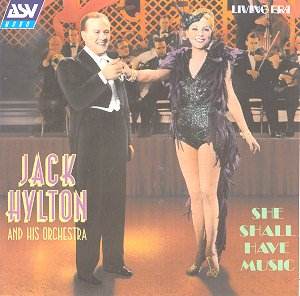 CD Reviews
CD Reviews
MusicWeb
Webmaster: Len Mullenger
Len@musicweb.uk.net
[Jazz index][Rock][Purchase CDs][ Film MusicWeb][Classical MusicWeb][Gerard Hoffnung][MusicWeb Site Map]
Jack HYLTON
(1892-1965)
She Shall Have Music Jack Hylton and
his Orchestra

1. She Shall Have Music Vocalist: Sam Costa
2. I Wonder Where My Baby Is Tonight Vocalist: Jack Hylton and
others
3. Me And Jane In A Plane Vocalist: Jack Hylton and others
4. The Best Things In Life Are Free Vocalist: Jack Hylton and
others
5. The Wedding Of The Painted Doll Vocalist: Sam Browne
6. You're The Cream In My Coffee Vocalist: Sam Browne
7. Breakaway Vocalist: Sam Browne
8. Singin' In The Rain Vocalist: Sam Browne and others
9. If I Had A Talking Picture Of You Vocalist: Sam Browne
10. Happy Feet Vocalist: Pat O'Malley and others
11. On The Sunny Side Of The Street Vocalist: Pat O'Malley
12. Tap Your Feet Vocalist: Pat O'Malley
13. Dancing On The Ceiling Vocalist: Pat O'Malley
14. You're Blasé Vocalist: Pat O'Malley
15. Black And Blue Rhythm Instrumental
16. Honeymoon Hotel Vocalist: Several
17. I Won't Dance Vocalist: Sam Browne
18. I'll Never Say "Never Again" Again Vocalist: Brian Lawrence
19. I'm In A Dancing Mood Vocalist: Bert Yarlett
20. Swing Is In The Air Vocalist: Alice Mann
21. September In The Rain Vocalist: Tom Wareing
22. The Darktown Strutters' Ball Tenor Saxophone: Coleman
Hawkins
23. My Melancholy Baby Tenor Saxophone: Coleman Hawkins Kiss Me Goodnight
Vocalist: Sam Browne and others
All tracks accompanied by Jack Hylton and his Orchestra
Recorded between 1925 and
1939
![]() ASV CD AJA 5390 [76:59}
ASV CD AJA 5390 [76:59}
Jack Hylton was one of the classic British performer-entertainers of the early 20th century. Brought up in a northern industrial town, Hylton was largely self-taught, and much of his musical ability was inherited directly from his father, a publican and amateur singer. As a child, Hylton had plenty of experience as a stand-in pianist and singer, but it was in 1909 that he found his true vocation as a conductor, when he began to direct touring pantomime.
The following year, the bright lights of the metropolis proved too much of a lure for Hylton, and an appointment as pianist-organist to the Alexandra Theatre and Cinema of Stoke Newington enabled him to establish a reputation in London.
The true development of the Hylton legend began between the two world wars. As music advisor to the army entertainment division Hylton had great influence on the light music scene during World War One, and became well renowned for his 'Hylton & Handley' duet partnership with pianist Tommy Handley.
The arrival of American jazz-dance music in Britain after the Armistice of 1918 provided more opportunities for Hylton as a pianist, and by 1921 he had been appointed leader and music arranger of a seven-piece band based in the Queen's Hall roof garden, a favourite dance venue of the time. Recordings for HMV followed, and by the mid 1920s Hylton's ensemble had become the No. 1 British recording band. He toured trans-continentally, and enjoyed an enviable reputation both at home and abroad.
The first nine tracks on ASV's CD were recorded around the end of the twenties, and the 'feel-good' smooth-dance numbers immediately capture the cultural excitement of the era. Cinematic advances saw the advent of the 'talkies', and Hylton capitalised on the commercial success of these films with 'cover' versions of hit musical standards including The Best Things in Life Are Free (1927) and Singin' In The Rain (1929).
By contrast, many of the later tracks are "cheer-up songs"; antidotes to the depression, both economic and literal, that followed the 1929 Wall Street Crash. Titles such as Happy Feet and On the Sunny Side of the Street are very upbeat, with catchy tunes and insistent bass lines.
When conscription caused the break-up of Hylton's orchestra at the beginning of World War Two, he instead turned to production, and became a theatre impresario of considerable note, renowned also as a producer and agent.
Hylton's voice is nasal, with a very fast vibrato, and some of his fellow vocalists sing with a richer tone, yet the style is typical of the period. The Orchestra's sound is similarly sickly, and the early recording set-up does not help sound quality. There are a number of intonationally wayward passages, particularly in the brass, but I am tempted to attribute this to audio distortion. In terms of remastering though, ASV has done a superb job: the recording is crisp and crackle-free.
It is easy to criticise the relentless uniformity of Hylton's style, but it is fair to remember that the original 78s would have lasted only a few minutes each side. This CD is best enjoyed in parts, as an attempt to listen to the CD in one sitting does begin to pall after a few minutes! For anyone nostalgic for the 1920s and 1930s though, this is charming. Highly recommended.
Simon Hewitt Jones